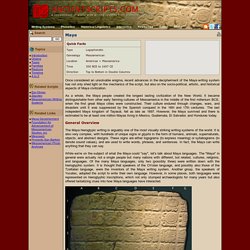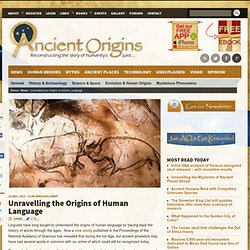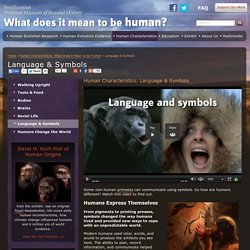

The Secret Language of Symbols. A Guide to The Structure of Spiritual Emblems There is a secret language we all recognize, but few are fluent in- the language of symbols.

Symbols surround us in myriad forms and form an inextricable part of our daily lives, yet unlike our spoken languages, schooling in symbolism is left to the individual initiative. Even in religious teaching, symbols are presented as emblems of belonging, mere historical artifacts one wears to identify with one’s faith. Prehistoric Cave-art. Prehistoric Cave Art: Prehistoric cave-art is important as it serves as some of the best means of showing the interaction between our primitive ancestors and the world as they perceived it.

The Image (right) is the most basic self portrait (From Pech Merle, c. 25,000 BP). Through it we can see the first steps of our awakenings as a species. There are certain characteristics of cave-art that allow us to begin to form an impression of the people behind the drawings, often found at the depths of long, deep tunnel systems in small secretive caverns. Quick Links: Article: Nature.com (May, 2013) 'The Earliest Known Cave Paintings Fuel Arguments About Whether Neanderthals Were The Mental Equivalent to Modern Humans'. Ancient Egyptian scripts (hieroglyphs, hieratic and demotic) Origins of Egyptian Hieroglyphs The ancient Egyptians believed that writing was invented by the god Thoth and called their hieroglyphic script "mdju netjer" ("words of the gods").

The word hieroglyph comes from the Greek hieros (sacred) plus glypho (inscriptions) and was first used by Clement of Alexandria. The earliest known examples of writing in Egypt have been dated to 3,400 BC. The latest dated inscription in hieroglyphs was made on the gate post of a temple at Philae in 396 AD. The hieroglyphic script was used mainly for formal inscriptions on the walls of temples and tombs. After the Emperor Theodsius I ordered the closure of all pagan temples throughout the Roman empire in the late 4th century AD, knowledge of the hieroglyphic script was lost. decipher the script.
Decipherment Many people have attempted to decipher the Egyptian scripts since the 5th century AD, when Horapollo provided explanations of nearly two hundred glyphs, some of which were correct. Notable features Numerals. Indus Script. Maya. Once considered an unsolvable enigma, recent advances in the decipherment of the Maya writing system has not only shed light on the mechanics of the script, but also on the socio-political, artistic, and historical aspects of Maya civilization.

As a whole, the Maya people created the longest lasting civilization of the New World. It became distinguishable from other early farming cultures of Mesoamerica in the middle of the first millenium BCE, when the first great Maya cities were constructed. Their culture endured through changes, wars, and disasters until it was suppressed by the Spanish conquest in the 16th and 17th centuries.
The last indepedent Maya kingdom of Tayasal, fell as late as 1697. Unravelling the Origins of Human Language. Ancient Origins seeks to uncover, what we believe, is one of the most important pieces of knowledge we can acquire as human beings – our beginnings.

While many believe that we already hold such knowledge, our view is that there still exists a multitude of anomalies and mysteries in humanity's past that deserve further examination. We therefore wish to foster an open community that is dedicated to investigating, understanding and explaining the origins of our species on planet earth. To this end, we aim to organize, support and even finance efforts in this direction.
Our aim is to move beyond theories and to present a thorough examination of current research and evidence and to offer alternative viewpoints and explanations to those currently held by mainstream science and archaeology. Come with us on a journey to explore lost civilisations, sacred writings, ancient places, unexplained artefacts and scientific mysteries while we seek to reconstruct and retell the story of our beginnings. Human Language. If you put an English speaker, a Mandarin Chinese speaker, and a Swahili speaker in the same room, chances are they'd have trouble communicating.

But according to one scientific theory, they're really all speaking the same language. Transcript Species-specific language. Language & Symbols. Early human creating cave art.

Image courtesy of Karen Carr Studio. Humans Express Themselves From pigments to printing presses, symbols changed the way humans lived and provided new ways to cope with an unpredictable world. Modern humans used color, words, and sound to produce the artifacts you see here. The ability to plan, record information, and communicate helped humans survive as climates fluctuated strongly. Ultimately, words and symbols led to language and the richness of modern human life. Communicating with color By 350,000 years ago With ocher and manganese, our ancestors marked objects and possibly their own skin. Humans may have first used ocher either as an adhesive or a pigment, and later to make artistic drawings and paintings.
Flattened areas on these pieces of pigment are signs of grinding or rubbing, telling us that they were held and used roughly like chunky crayons. Illustration of an ancient child burial. Ancient Burials By 100,000 years ago Child burial 24,000 years ago Costs.